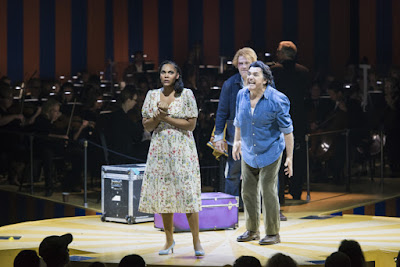 |
| Michael Mays in "Pagliacci" (photo: BLO) |
Opera lovers (and we are legion) typically attend a duo program of Leoncavallo's Pagliacci and Mascagni's Cavelleria Rusticana, with such frequency that they are fondly referred to as Cav and Pag, or more humorously as Ham and Eggs. For its initial production of the season, however, Boston Lyric Opera has chosen to present just Leoncavallo's 1892 work, while creating a thoroughly immersive carnival atmosphere that beckons the audience to a more active role, with unexpectedly enjoyable results, and some well-cured ham. That would be the foreplay performed by circus folks, with decidedly comedia del arte touches, outside the operatic stage, with sideshow tents, jugglers, food trucks and the like.
 |
| Lauren Michelle, Michael Mayes & Rafael Rojas in "Pagliacci" (photo: BLO) |
This may seem like an oxymoronic approach to introduce what will become a very tragic night, but one must remember that the story it tells, despite the famed aria about a laughing clown, (Vesti la giubbe), is literally deadly serious, not to mention that the opera's title translates as Clowns. At its heart it is a relatively simple fable of love, jealousy and murder (all the things operagoers love) with a bit of purposeful upstaging in the extreme. It's oddly sung in English and Italian, (mostly the former) with sometimes silly English translation by Bill Bankes-Jones. (Leoncavallo must be rolling in his grave over such lines as “where's the frickin' chicken?”). This production is performed in about ninety intermissionless minutes (originally divided up into a prologue and two acts), and, because of the novel way it is being presented, it becomes a play within a play within a play.
 |
| Tobias Greenhalgh & Lauren Michelle in "Pagliacci" (photo: BLO) |
As is often the case, BLO takes on operatic challenges (even when presenting war horses) and succeeds in revitalizing them, with respect not only to form but also to venue (in this case, a revisit to the Steriti ice skating rink in the North End). The cast, as is typical for BLO, was outstanding, consisting of only five soloists (but a crackerjack chorus of some thirty-two, under Chorus Master Brett Hodgdon). They include Canio (Rafael Rojas), Nedda (Lauren Michelle), Tonio (Michael Mayes), Silvio (Tobias Greenhalgh) and Beppe (Omar Najmi). Michelle was outstanding, matched by both Greenhalgh and Rojas (who, it was announced, was indisposed, though his performance never seemed less than memorable). Once again, Conductor David Angus led the BLO Orchestra, with Stage Direction by David Lefkowich (too often showing undisciplined crowd movement that detracted from sight lines and distracting call/responses), minimalist Set Design by Julia Noulin-Merat, witty Costume Design by Charles Neumann, and Lighting Design by Pablo Santiago. On virtually every level this was a crowd-pleaser, even with its topsy-turvy tragicomical story.
 |
| Rafael Rojas in "Pagliacci" (photo: BLO) |
So,
laugh and cry, fellow clowns, until October 4th
(the October 6th
matinee is sold out already) at the North End skating rink, a perfect
choice of venue given the opera's Italian sources and sauces.





















